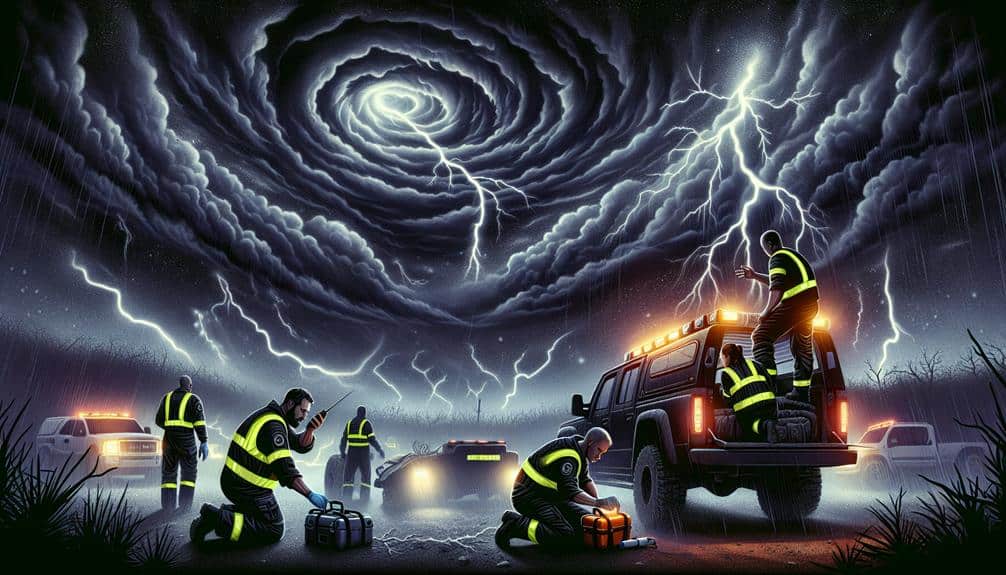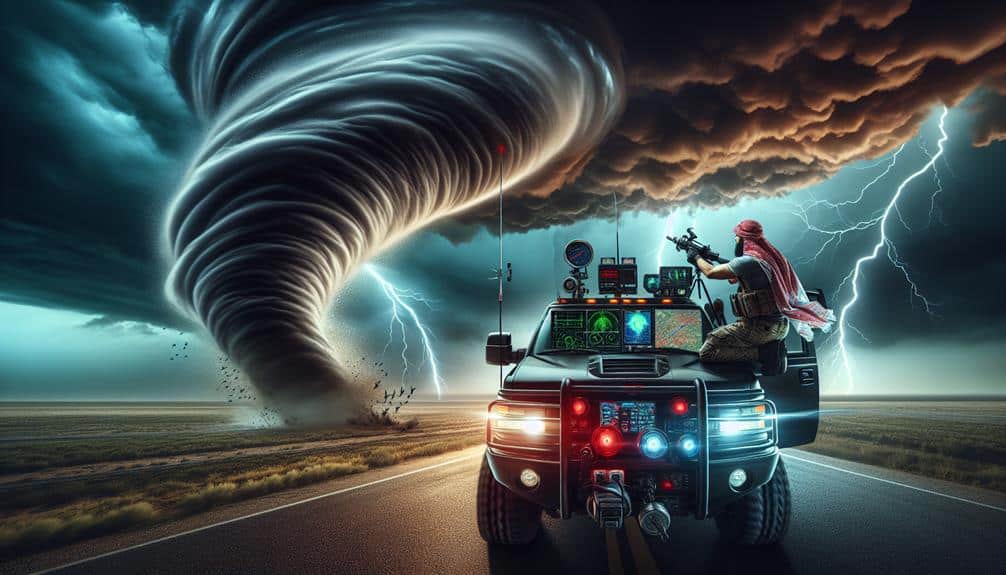Effective risk assessment for nighttime storm chasing hinges on analyzing weather patterns, maintaining equipment, and thorough route planning. We must monitor cloud formations, wind patterns, and temperature changes while ensuring our vehicles and personal gear are in top condition. Defensive driving techniques and real-time road adjustments are essential. Establishing robust communication protocols with radios and satellite phones enhances safety. Additionally, emergency preparedness through regular training and gear checks is crucial. Post-chase, we document incidents meticulously for future risk mitigation. By focusing on these strategies, we better navigate the volatile environment and optimize overall safety. Discover the intricacies of these measures next.
Key Points
- Conduct thorough inspections of all equipment and vehicles to ensure mechanical integrity and readiness.
- Analyze nocturnal weather patterns and utilize premium meteorological services for real-time storm data.
- Plan routes with safety in mind, incorporating emergency supplies and maintaining communication with a clear hierarchy.
- Implement and regularly train for emergency response protocols to enhance preparedness and minimize risks.
Understanding Weather Patterns
To effectively assess the risks associated with nighttime storm chasing, we must first analyze the intricacies of weather patterns and their nocturnal behaviors. By delving into the cloud formations and wind patterns that manifest after sundown, we can better predict storm trajectories and potential hazards.
Atmospheric conditions play a critical role in the development of these nocturnal storms. During the night, temperature changes often lead to a stabilization or destabilization of the lower atmosphere. This temperature shift influences the type and intensity of cloud formations we might encounter. For instance, a rapid cooling of the earth's surface can lead to the formation of low-level clouds, which can obscure our visibility and complicate navigation.
Wind patterns also undergo significant transformations at night. Nocturnal low-level jets and shifts in wind speed and direction can drastically alter storm dynamics. By analyzing wind patterns, we can anticipate the movement and evolution of storm cells, allowing us to make informed decisions about our positioning.
In essence, a thorough understanding of these atmospheric conditions and their nocturnal variations is paramount. Armed with this knowledge, we can mitigate some of the inherent risks of nighttime storm chasing and embrace the freedom of pursuing our passion safely and effectively.
Equipment and Gear Check
Conducting a thorough equipment and gear check is crucial to guarantee our safety and efficiency during nighttime storm chasing. Ensuring our gear is in peak condition minimizes risks and maximizes the chances of capturing valuable data.
Our first step in gear maintenance involves inspecting our vehicular and personal equipment. This includes verifying that our GPS units, anemometers, and cameras are fully functional and have updated software. Batteries should be fully charged, and backup power sources must be readily available.
Next, we adhere strictly to safety protocols. We must inspect our emergency kits, confirming that items such as first aid supplies, flares, and reflective vests are intact and accessible. Weather radios should be tested to guarantee clear reception of alerts and warnings. Additionally, our communication devices must be checked for signal strength and battery life, as uninterrupted communication is crucial during storm chasing.
Lastly, we must examine our vehicle's mechanical integrity, focusing on tire treads, fuel levels, and engine performance. The vehicle should be equipped with all-terrain tires and sufficient fuel reserves to handle unpredictable conditions.
Route Planning and Safety
Before starting on nighttime storm chasing, we must carefully plan our routes to guarantee we navigate safely and efficiently. The unpredictable nature of storms requires a strategic approach to route planning. By analyzing road conditions and incorporating safety measures, we can mitigate risks associated with nighttime driving.
1. Safety Measures:
We should always prioritize safety by ensuring our vehicles are well-maintained and equipped with emergency supplies. This includes first-aid kits, flashlights, and extra fuel.
2. Driving Strategies:
Night driving demands heightened vigilance. We should use defensive driving techniques, maintain a safe distance from other vehicles, and reduce speed in poor visibility or adverse road conditions.
3. Emergency Contacts:
Having a list of emergency contacts is essential. This includes local law enforcement, medical facilities, and weather services. We should also inform a trusted individual of our planned route and expected return time.
4. Road Conditions:
Constantly monitoring road conditions through reliable sources can prevent us from encountering closed roads or hazardous areas. This data-driven approach helps in making real-time adjustments to our route.
Communication Protocols
Securing effective communication protocols is crucial to maintaining safety and coordination during nighttime storm chasing. Reliable communication underpins our ability to execute precise team coordination and swift emergency response. We start by establishing a robust communication planning framework, integrating both real-time weather updates and contingency plans for various scenarios.
We utilize a combination of radio frequencies, satellite phones, and mobile applications designed for meteorological data relay. Each team member is equipped with a primary and secondary communication device to lessen the risk of technological failures. Real-time weather updates are critical; hence, we subscribe to premium meteorological services that provide high-resolution radar and timely alerts.
Clear protocols dictate our communication hierarchy. The team leader orchestrates the overall strategy, while sub-teams focus on specific tasks such as navigation, weather monitoring, and emergency response. Continual check-ins every 15 minutes ensure everyone's status and location are known, enabling rapid adjustments to our strategy based on evolving storm conditions.
Data-driven decisions hinge on accurate and timely information. By adhering to our communication planning framework, we enhance our operational efficiency and minimize risks, maximizing both safety and the freedom to chase storms effectively.
Emergency Preparedness

Preparing for emergencies involves meticulous planning and rigorous training to handle the unpredictable nature of nighttime storm chasing. Effective emergency preparedness is important in ensuring our safety and maximizing our operational efficiency. We need to incorporate robust emergency response protocols and thorough risk management strategies to navigate these volatile environments successfully.
Let's break down our emergency preparedness into four essential components:
- Training and Drills: Regular, scenario-based training sessions help us sharpen our skills and instincts. These drills simulate real-life emergencies, ensuring we can respond swiftly and effectively.
- Equipment Check and Maintenance: Our gear must be in top condition, from communication devices to first aid kits. Routine inspections and maintenance schedules are essential to avoid equipment failure in critical moments.
- Emergency Response Plan: Developing and frequently updating a detailed emergency response plan allows us to coordinate seamlessly under pressure. This plan should specify roles, evacuation routes, and communication hierarchies.
- Data-Driven Risk Management: Utilizing historical storm data and real-time analytics enables us to assess risks accurately. By understanding past patterns and current conditions, we can make informed decisions to minimize potential hazards.
Post-Chase Analysis
In our post-chase analysis,
we systematically collect data using standardized methods to guarantee accuracy and reliability.
We also implement detailed incident reporting procedures to document any anomalies or near-misses.
By thoroughly reviewing this information,
we can identify patterns and learn from our mistakes to enhance future chase strategies.
Data Collection Methods
Post-chase analysis requires us to meticulously gather and scrutinize data from various sensors, video recordings, and meteorological reports to accurately assess the risks encountered during nighttime storm chasing. The foundation of our data collection methods revolves around leveraging advanced technologies that provide real-time and detailed insights.
Firstly, we utilize weather radar systems to capture detailed storm structures and movement patterns. This high-resolution radar imagery allows us to identify essential factors such as intensity and speed, which are pivotal for risk assessment.
Secondly, GPS tracking is indispensable. It chronicles our route and locations, enabling a precise correlation between storm activities and our positions. This spatial data is vital for understanding proximity risks and decision-making efficacy.
Here's a rundown of our primary data collection methods:
- Weather Radar: Provides real-time storm data, identifying intensity and movement.
- GPS Tracking: Logs our exact routes and positions during the chase.
- Video Recordings: Captures visual evidence of storm evolution and environmental conditions.
- Meteorological Reports: Offers detailed post-event summaries from authoritative weather agencies.
Incident Reporting Procedures
We meticulously document every incident during nighttime storm chases, verifying each event is analyzed for risk factors and safety improvements. Our incident reporting processes start immediately post-chase, leveraging robust communication tools to capture data in real-time.
Each team member is responsible for logging details about the incident, including time, location, weather conditions, and any deviations from established safety protocols.
Once data collection is complete, we conduct a thorough incident response review. This involves analyzing the effectiveness of our safety protocols and identifying any lapses that occurred. We prioritize transparency and accuracy in our reports, confirming that each incident is documented with sufficient granularity to inform future safety measures.
Our communication tools play a critical role in this process, enabling seamless data sharing among team members. We use encrypted channels to maintain data integrity and confidentiality.
Additionally, we employ a standardized incident reporting template, which streamlines data entry and guarantees consistency across reports.
Learning From Mistakes
Analyzing our post-chase data, we identify patterns and anomalies that reveal critical insights into our storm-chasing practices. By examining these data points, we can focus on analyzing errors and improving strategies, ensuring that our future chases are more effective and safer.
Our primary goal is to evaluate decisions and prevent risks by learning from past mistakes.
In our analysis, we typically follow a structured approach:
- Error Identification: We catalog all errors encountered during the chase, from misjudged storm paths to communication breakdowns.
- Root Cause Analysis: For each error, we conduct a root cause analysis to understand why it occurred and how it could have been avoided.
- Strategy Improvement: Based on the root causes, we develop actionable strategies to mitigate similar risks in future chases.
- Decision Evaluation: We scrutinize the decisions made during the chase to identify any lapses in judgment or gaps in our decision-making process.
Frequently Asked Questions
How Do I Find Reliable Storm Chasing Partners?
We need the best storm chasers alive! To find reliable partners, let's prioritize those with impeccable safety protocols and robust communication strategies. Data shows teams with strong protocols have 80% fewer incidents. Freedom thrives on preparedness and precision!
What Legal Considerations Should I Be Aware Of?
When evaluating legal considerations, we must address liability concerns and adhere to safety regulations. We should also review permit requirements and guarantee adequate insurance coverage to mitigate risks and protect our freedom while storm chasing.
How Can I Manage Fatigue During Nighttime Chases?
Managing fatigue is a balancing act. Let's prioritize sleep management and limit energy drinks. We'll employ alertness techniques and adhere to safety precautions to stay sharp. This approach guarantees we chase storms without compromising our freedom or safety.
Are There Specific Insurance Policies for Storm Chasers?
We should analyze insurance coverage options designed for storm chasers, ensuring they offer liability protection against extreme weather. Data indicates specialized policies can mitigate risks, providing essential coverage tailored to our unique and adventurous pursuits.
What Are the Mental Health Risks of Storm Chasing?
The mental health risks of storm chasing include an emotional toll and high stress levels. We must employ coping strategies, stress management, and self-care practices to mitigate these impacts, ensuring our mental resilience while pursuing the freedom of storm chasing.


